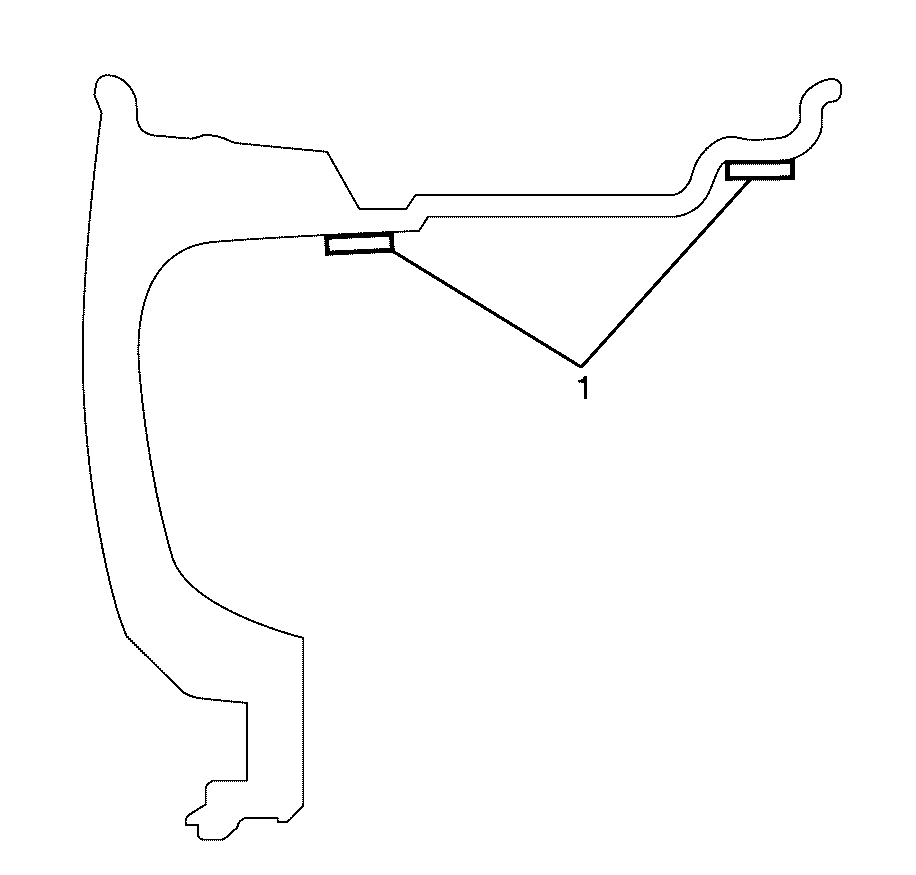Tire and Wheel Balancing Off Vehicle CSV SWBHSV VXR8
Wheel Weight Usage - Type B
Important: Clip-on wheel balance weights are not suitable for the following wheels sizes. Stick-on adhesive weights must be used.
Model | Engine | Wheel | Tyre Designation |
|---|---|---|---|
CR8 / Senator | V8 | 8.0J x 19 alloy | 245/40 ZR19 98Y |
GTS | V8 | 8.0J x 20 alloy | 245/35 ZR20 95Y |
CR8 / Senator | V8 | 9.5J x 19 alloy | 275/35 ZR19 96Y |
GTS | V8 | 9.5J x 20 alloy | 275/30 ZR20 97Y |
Wheel Weight Placement - Adhesive Weights
Important: When installing adhesive balance weights on flangeless wheels, do not install the weight on the outboard surface of the rim.
Adhesive wheel balance weights may be used on factory aluminium wheels. Perform the following procedure to install adhesive wheel balance weights.

- Determine the correct areas for placement of the wheel weights on the wheel (1).
- Make sure that there is sufficient clearance between the wheel weights and brake system components.
- Clean the designated balance weight attachment areas.
- Dry the attachment areas with hot air until the wheel surface is warm to the touch.
- Warm the adhesive backing on the wheel balance weights to room temperature.
- Remove the protective covering from the adhesive backing on the back of the balance weights.
- Install the wheel balance weights to the wheel.
Important: On Type B wheels, any outer balance weights should align with the spokes of the wheel.
Important: To ensure proper adhesion on Type B wheels, locate stick-on balance weights on flat surfaces only.
When balancing, separate adhesive weight planes as much as possible, minimising the weight required to balance the wheel and tyre assembly.
Important: Do not use abrasives to clean any surface of the wheel. The balance weight attachment areas must be free from corrosion, dirt, oil or any other foreign material.
Important: Do not touch the adhesive surface.
Important: Press the wheel balance weights into place with firm hand pressure.
Tire and Wheel Balancing Off Vehicle LWB SWB
Important: The tyre and wheel assembly must be balanced off vehicle before attempting to balance the tyre and wheel assembly on vehicle. Refer to Tire and Wheel Balancing .
If after following the tyre and wheel vibration diagnostic process, some amount of tyre and wheel vibration is still evident, an on-vehicle high-speed spin balancer may be used to perform an on-vehicle balance in an attempt to finish balance the tyre and wheel assemblies, wheel hubs, brake rotors and wheel trim, if equipped, simultaneously. On-vehicle balancing can also compensate for minor amounts of residual runout encountered as a result of mounting the tyre and wheel assembly on the vehicle, as opposed to the balance which was achieved with the off-vehicle balancing procedure.
Important: Note the following information before performing
the on-vehicle tyre and wheel balance:
• Vehicles equipped with low profile, wide tread path, high performance
tyres and wheels are susceptible to small amounts of dynamic imbalance. • When performing an on-vehicle balance, care must be taken when placing
the wheel balance weights on the wheels. If the wheel balance weights are not placed
accurately, they can induce dynamic imbalance and increase the severity of the vibration. • Inspect the wheel bearings to ensure that they are in good condition.
Refer to
Front Wheel Bearing and Hub Replacement
or
Rear Wheel Bearing and Hub Replacement
. • Thoroughly inspect all on-vehicle balancing equipment and make sure that
it is within the manufacturer's recommended specifications. • Do not remove the off-vehicle balance weights. The purpose of on-vehicle
balance is to fine tune the assembly balance already achieved off-vehicle, not to
start over. • Leave all wheel trims installed whenever possible. • If the on-vehicle balancer calls for more than 56 g (2 oz)
of additional weight, split the weight between the inboard and outboard flanges of
the wheel, so as not to upset the dynamic balance of the assembly achieved in the
off-vehicle balance. Perform the on-vehicle balancing procedure in accordance
with the on-vehicle balancer manufacturer's instructions.
